So, you’ve worn your Birkenstocks in and they are as comfortable as a second skin (woohoo!), but then you notice the footbed turning a nasty black color (uh oh!). As a long term fan of Birkenstocks I’ve certainly encountered this problem and found it quite embarassing.
Does this mean your Birkenstocks are stained for good? Can you still wear them? Can you clean them? And can you prevent new Birks from blackening in the same unslightly way?
Lucky for you the answer is an all-around YES to each of those concerns.The secret lies in knowing what turns your beloved Birkenstocks black in the first place.
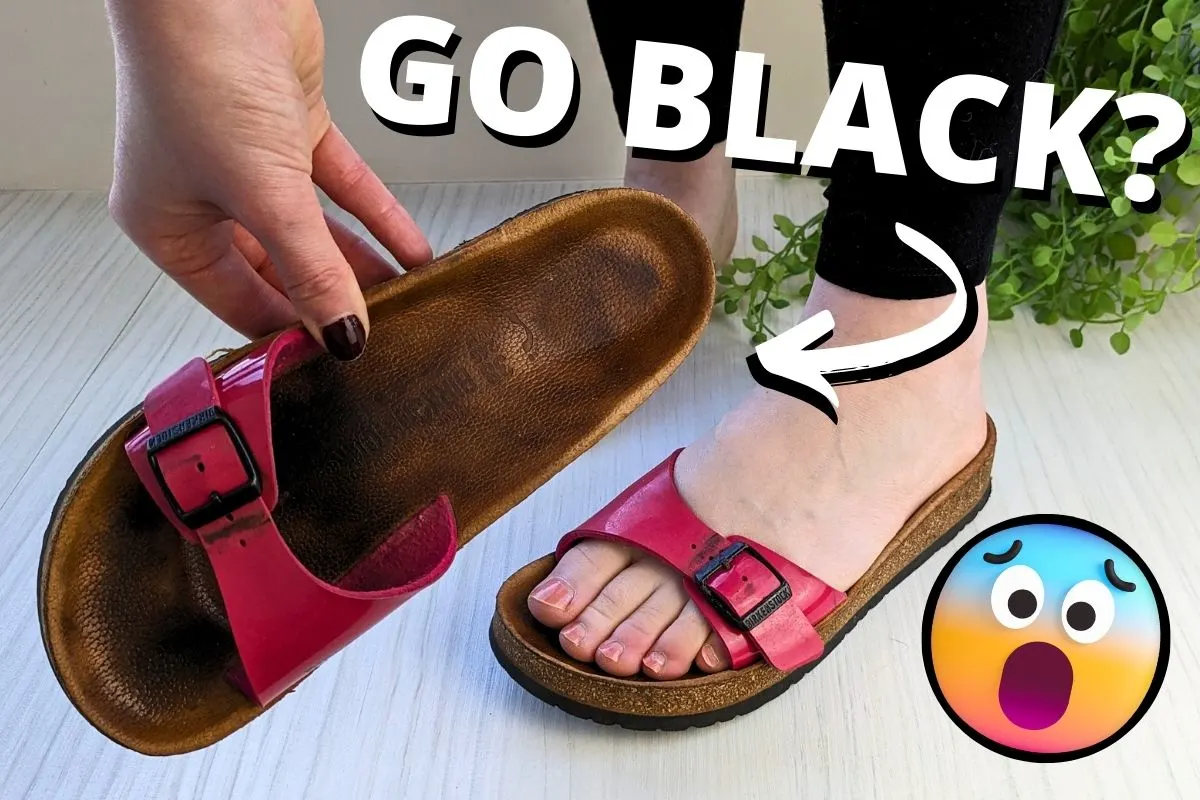
Birkenstocks turn black because your feet secrete oil when they sweat. Dirt gets ingrained in the footbed and makes discoloration worse with use. The footbed reacts to the oil from your feet and blackens over time. You can help prevent these black stains by keeping your feet and shoes clean and dry, and by using an antiperspirant foot spray.
If this heavily grosses you out, there are some footbeds in the Birkenstocks range which won’t turn black and slimy. Their EVA range won’t turn black and can be easily cleaned, and their microfiber footbeds are also a good stain-resistant option. You can take a look at these options here.
Despite the benefits of wearing Birkenstocks, the classic cork footbed needs special care to keep it looking fresh.
*This page may contain affiliate links. As an Amazon Associate I earn from qualifying purchases at no additional cost to you. Learn More.
My Experience
Black footbeds are a common concern for Birkenstocks fans, including myself. I find a pair of Birkenstocks will start to blacken after a summer of heavy use, which isn’t ideal.
Here’s one of my well-loved old pair of Birkenstocks, with a black footbed so you can see what I mean:
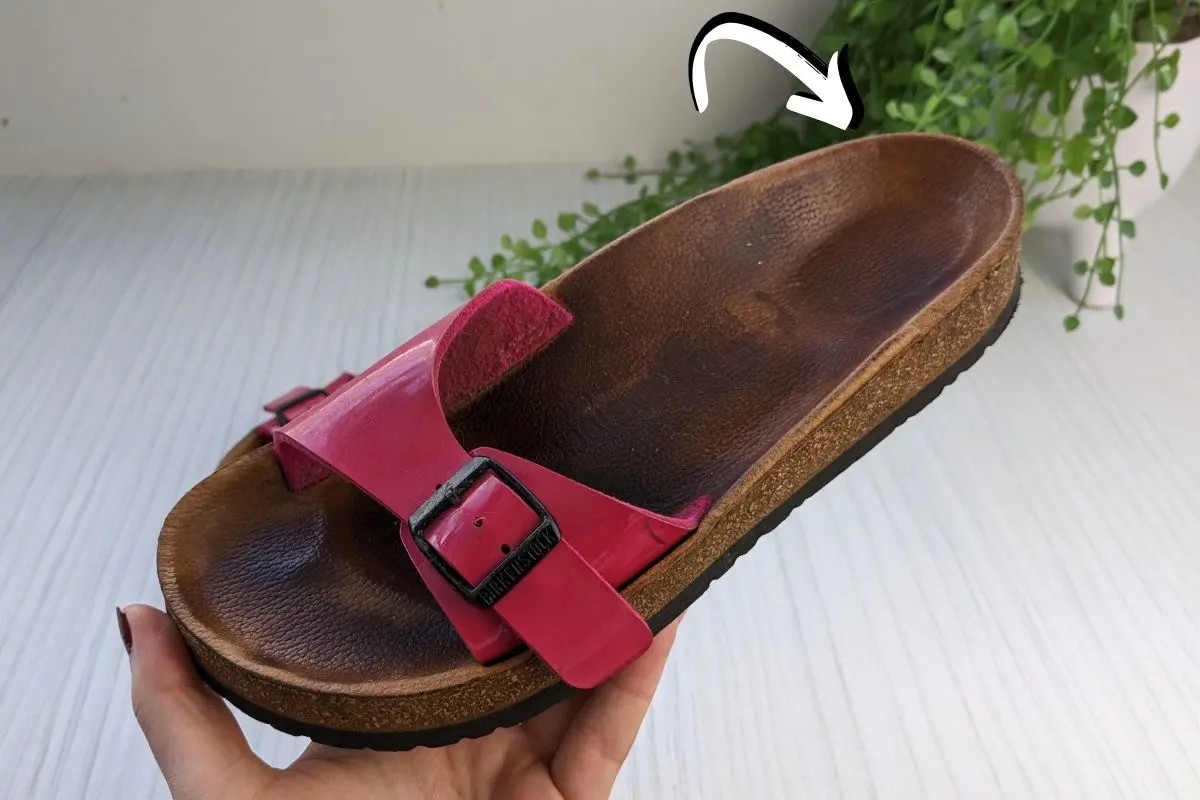
Fortunately, the black staining is both preventable and fixable (phew!). I’m currently breaking in a new pair of Arizonas and so far I’ve managed to keep the footbeds looking fresh this time.
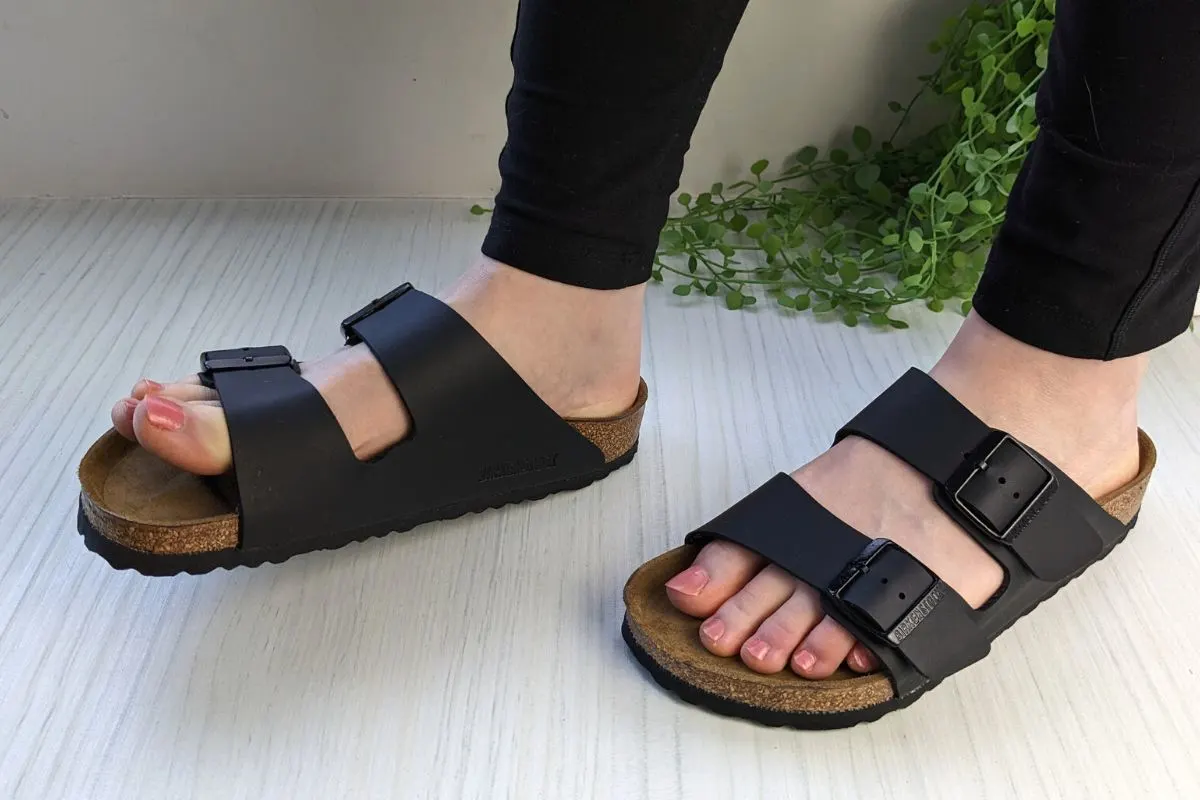
Here’s a video of me showing the black marks on my Birkenstocks:
I’ll be avoiding the mistakes of the past with this pair, and sharing my best tips with you here.
In this article I’ll be covering ways that I prevent my new pairs of Birkenstocks ending up like blackened pairs of the past, plus ways you can spruce up your pair if they have already started to darken.
You may also like: Do Birkenstocks Run Big? Sizing Guide Plus Charts
How To Get Rid Of Black Stains On Birkenstocks
Suppose your Birks are well and truly shaped to your feet, and you’ve got some good mileage breaking them in. You’ll likely notice the footbed lining starting to darken, which doesn’t look hygienic or appealing.
Worry not! You can fix this in several ways:
- Regularly cleaning your shoes goes a long way to keeping black marks at bay. Birkenstock sells a shoe cleaning kit specifically designed to keep the Birk footbed clean. The kit contains water and stain repellent, a cleaner and refresher, a soft cleaning brush, and a cork sealer. Investing in the kit will help you get more life out of your Birks!
- Mix ½ teaspoon of soft liquid detergent with 2 cups of water and gently clean your shoe’s footbed with the mixture and a soft brush. Don’t scrub harshly or vigorously; you will damage the suede lining. Another caution is not to over-saturate the sole. This can damage your Birk and, worse still, eventually cause your shoe to turn moldy.
- Gently clean the footbed using a soft toothbrush and wipe them off with a damp cloth. A vinegar and liquid detergent mix also does the trick. Use ½ teaspoon of gentle liquid detergent, two cups of warm (not hot) water, and two teaspoons of vinegar.
- Baking soda is excellent as a shoe cleaner. Make a smooth paste with 2/4 of a cup of baking soda and some water. The paste must be smooth. Gently clean your shoe’s surface with a soft brush until the dirt loosens and the black marks fade. If the stains on your footbeds persist, leave the mixture overnight. This will lift tough stains.
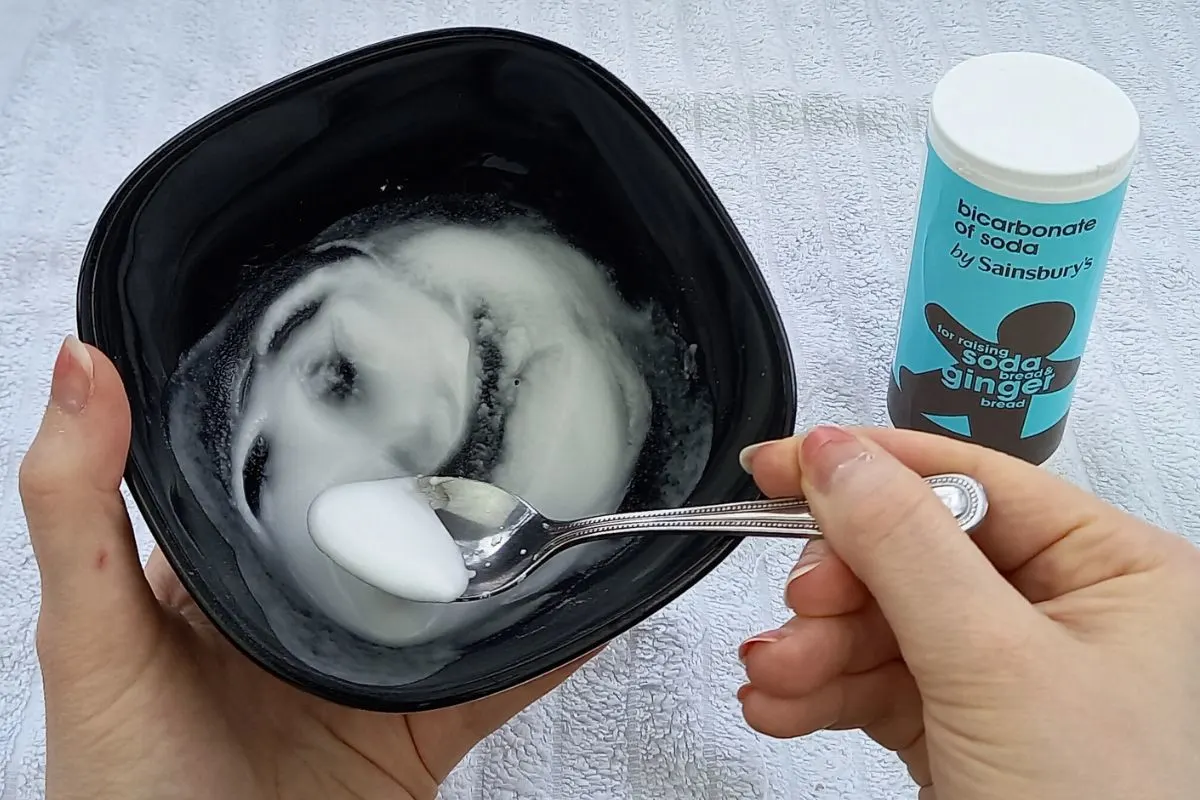
- A leather cleaner also works on suede footbeds but use it sparingly.
- An unconventional way to clean suede footbeds is to gently sand the suede with ultra-fine-grained sandpaper. This removes stains but can ruin the footbed if you sand too vigorously.
- If your shoes haven’t yet turned black, it pays to clean them thoroughly anyway. To do this, sprinkle some baking soda on the soles, plus your shoes in freezer bags, and freeze them overnight. This will remove dirt buildup in the footbed’s lining.
- Clean the inside of closed shoes occasionally, or better still, wipe them with an ever-so-slightly damp cloth after each wear. Please make sure they are 100% dry before you wear them again.
If The Black Won’t Budge Swap Out Your Footbed
A black footbed that won’t budge doesn’t spell the end of your shoes. Birkenstock also supplies replacement footbeds should your shoe lining stain excessively due to wear and tear.
There is a wide range of insoles and footbeds to choose from:
- Super Birki Replacement Footbed in black
- Blue Footbed Sport in blue
- Blue Footbed Tradition in blue
- Comfort Insole Birko Tex in blue
- Comfort Toeless Insole Leather in brown
- Birko Basic in black
- Comfort Insole Microfiber in black
- Blue Footbed Tradition Black Edition in black
- Comfort Insole Leather in brown
- Birko Balance Insole in brown
- A630/A640 Replacement Footbed in gray
- Birko Active in black
- Comfort Insole Birko Tex in brown
- Blue Footbed Sport Black Edition Textile in black
- ¾ Length Insole Birko-Tex in brown
- BirkoContact Sport Microfiber in blue
- Insole Pelotte in brown
- Birko Classic Plus in black
- Birko-Flex Arch Support in white
- Birkco Classic in black
How To Stop Birkenstocks Turning Black
It’s always better to prevent than to treat! Although you may not be able to permanently stop your Birkenstock soles from turning black, you can do a sterling job of minimizing discoloration.
Here are my 7 top tips to help stop Birkenstocks turning black:
- Never put damp feet into your Birks. Ensure your feet are completely dry before slipping on your shoes. However tempting it may be to slide on your Birks after a shower or swim, don’t. Not only will moisture discolor the footbed, but moisture also damages the cork and, strangely enough, dries it out and makes it less flexible and prone to warping.
- Do not put too much moisturizer on your feet before wearing Birkenstocks. Too much foot cream will make your feet sweat even more.
- Wipe your Birks off after every wear. This will remove dirt before it settles into the suede lining and eliminate sweat built up during the day.
- Clean your shoes with a baking soda paste as soon as you notice any color developing on your Birk’s suede sole lining.
- Use an antiperspirant foot spray when you are out and about. If you don’t have an antiperspirant foot spray, a normal antiperspirant sprayed onto your feet’s soles works well.
- A good absorbent foot powder is a very effective product to keep your feet dry. Dust a small amount onto your feet before you step out in your Birks.
- Keeping your feet cool is an effective way to keep sweat in check. Birkenstock sells a cooling foot cream containing menthol to refresh your feet. Squalane is an ingredient in the cream that provides lightweight moisture and has anti-inflammatory benefits. There are many other effective foot-cooling products on the market too.
You may also like: Why Are Birkenstocks So Popular? 10 Reasons
Why Birkenstocks Go Black In The First Place
Although Birkenstocks have many health benefits, a huge hygiene concern is their footbeds turning black and slimy. This is a universal problem (it’s not just you!) for those who enjoy these sandals.
Birkenstock’s footbeds are lined with super-soft suede. Suede does not react well to oils; feet secrete oil when they sweat.
A further challenge is dirt that sneaks into your shoes and, with friction, becomes ingrained in your Birk soles, compounding stains into the cork.
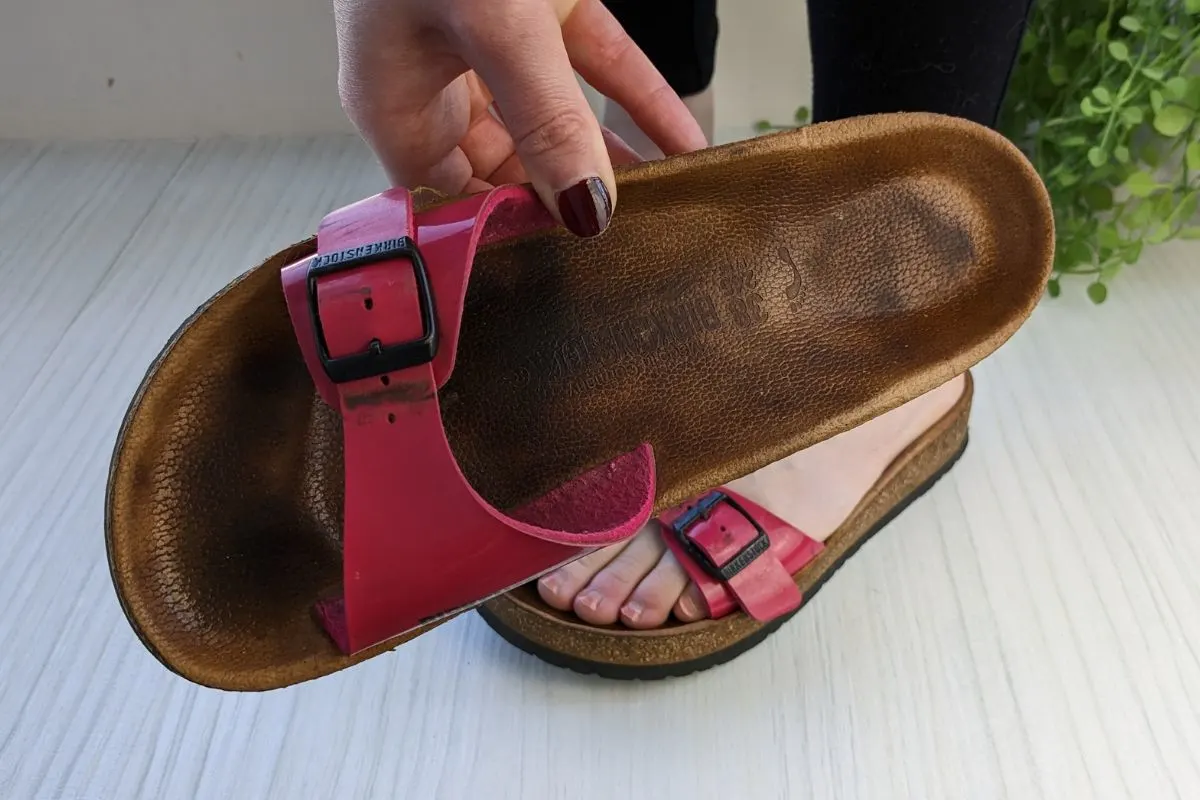
An interesting fact about feet isthey have 125,000 sweat glands! Each foot has more sweat glands per centimeter than any other body part – crazy right? As a result, your Birkenstocks are bound to turn black over time through no fault of your own.
A word of caution is to keep your Birks dry and let them air. Birkenstocks do not fare well with unnatural heat sources and direct sunlight. Please don’t attempt to dry them with a hairdryer; this will damage your shoes. Damp Birkenstocks grow mold on the footbed, and black patches can get super slimy, so keeping them dry is key.
The good news is that a black Birkenstock sole does not mean your go-to comfort shoes are ruined; if you don’t mind how the stains look just keep wearing them. Stains are usually a sign of a well worn-in pair, which means when they start to appear your Birkenstocks will likely be at their most comfortable and formed to your feet.
Some Birkenstocks Go Blacker Than Others
Let’s take a look at the different Birkenstock footbed options, and how they react to sweat and oil secretions.
| Footbed | Reaction To Sweat And Oil Secretions |
| Suede | Suede doesn’t cause feet to sweat, it keeps them cool, but it absorbs any moisture and oil secretions that discolor the footbed. |
| EVA | EVA is not affected by moisture; therefore, the footbed does not discolor when wet. An EVA footbed is easy to wash and keep clean. |
| PU (Polyurethane) | Birkenstock Professional Range has footbeds lined with fabric. The footbeds are removable and can be washed at up to 60 degrees Celsius water temperature. Since these footbeds are easy to keep clean, they are less likely to build up residue. |
| Shearling | Shearling does not cause your feet to sweat due to its natural fiber makeup. Although shearling insulates heat and keeps your feet warm, your shearling-lined Birks will not turn black like the suede-lined shoes. |
| Microfiber | Microfiber is moisture-wicking but retains heat. Even though the moisture from your feet won’t easily build up on the microfiber footbed, the footbed may feel warmer than Birks’ suede lining. |
Based on the above information you can decide which footbed you think will be best for you.
Frequently Asked Questions
Are Black Birkenstock Footbeds Unhygienic?
The stains on your Birk footbeds are caused by moisture, sweat, and dirt. If you don’t keep your footbeds clean and dry, bacteria may cause mold to develop on your footbed and in the cork sole. This can lead to foot health problems.
Do All Birkenstock Footbeds Turn Black?
No, they don’t; some footbeds are moisture-wicking and displace moisture instead of absorbing it. The Birkenstock microfiber footbeds are an option if this concerns you. The Birki range made from EVA also doesn’t turn black. These footbeds are not affected by moisture and can quickly be wiped off and dried. PU footbeds can be removed and washed to keep them from discoloring.
Conclusion
Birkenstock soles turn black because your feet sweat, and sweat causes the footbed lining to darken. You can clean black footbeds using the Birkenstock cleaning kit, a soft liquid detergent, a baking soda paste, or a vinegar solution. To prevent your Birks from turning black, keep your feet clean and dry, wipe your shoes down regularly, and use a deodorizing foot spray.
For more Birkenstocks content, check out:
Are Birkenstocks Comfortable? My Experience (Plus Photos)
How To Break In Birkenstocks Fast – 10 Ways (My Experience)
Are Birkenstocks Good For Flat Feet? 2 Podiatrists Weigh In
Why Birkenstocks Are The Worst Shoe (7 Reasons)

Lorna is a footwear geek and the founder of Wearably Weird. She created a YouTube channel in 2021 for fellow footwear fanatics, dedicated to detail-rich footwear reviews and info. She has a fashion media qualification (awarded in 2011).
